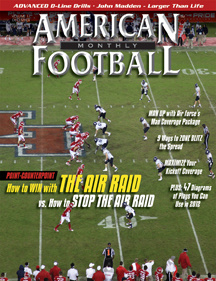Article CategoriesAFM Magazine
|
From the Coach’s Bookshelf – Madden - Larger Than Lifeby: Bryan Burwell© More from this issue In Madden, longtime sports columnist Bryan Burwell has written the first comprehensive biography of this living legend. From his days as a star athlete in Daly City, California, Madden was driven to succeed, a trait that helped him persevere during his tumultuous years with the Raiders under Al Davis and compelled him to try his hand at broadcasting after his coaching career was over. John Madden is arguably one of the two or three most unique men in the history of American professional football. Legendary coach. The greatest TV football commentator ever and maybe the greatest sports commentator ever. And now, in his third professional incarnation, he is a marketing force and pop-culture icon. How many people can lay claim to having influenced generations of NFL fans in three separate but equally legendary careers? Madden’s story does not begin with him as a football coach, but you will see that his coaching career is the defining chapter of his life. You might need to be reminded of that now, because no one under the age of 45 can attest firsthand to the genius of Madden as a coach. Generation X only knows him as a video-game icon and Madison Avenue pitchman, and one must be older than 30 to have witnessed and fully appreciated the majority of his career as a sports-broadcasting giant. But Madden is first and foremost a coach. He began his coaching career chomping nervously on a towel wrapped around his neck, berating officials with expletive-laced rants from the sideline. He was 33 years old, the youngest head coach in pro football, working for Al Davis’ Oakland Raiders. He broke the mold of the traditional football coach not with an iron hand and a clenched jaw or an intractable regiment. Instead, he did it with a wink and a smile, charming his band of outrageous renegades. It was the late 1960s and pro football was different then. It was more primeval, less show business. It was Old Testament football, where players didn’t wait for a commissioner to pass judgments on anyone who dared to break the written or unwritten rules of the game. They issued punishments in mean, violent and unrepentant ways that made it clear justice would be served. If the players were different then, so were the coaches. They were larger-than-life authoritarians like Vince Lombardi. NFL players lived a “my way or the highway” existence and had to answer to the stringent authority of coaches who had many roles – shirts and ties, curfews, and lots of other requirements that had nothing to do with winning games or collecting championships. Men like Lombardi were the last bastions of conservatism in an ever-changing world. They drew their unwavering lines in the sand and forced every athlete so submit to their crew-cut, buttoned-down methods, even if it was clear that society’s buttoned-down attitudes were on the way out. Then along came John Madden, the antithesis of the conservative coaching ethos. He didn’t believe in a lot of rules. He didn’t care much about how a player dressed, what he did away from the field, how long his hair was, how late he stayed out at night, or any of the other things most head coaches of his time obsessed over. He operated with the simplest rules that anyone in football – hell, anyone in all of American sports – had ever heard. “Be on time, pay attention, and play like hell when I tell you to.” His was a locker room full of reprobates and rascals who were partaking fully in the rich epicenter of American radicalism that was spawning all over the San Francisco Bay Area. Madden chose to lead – not harass, handle, or manage - these grown men in a way no one had dared to do before. “I think he was [the first player’s coach]”, said Howie Long, the Hall of Fame defensive end who played for the Raiders just after Madden retired. “When I walked into that locker room, there were a lot of guys that John brought up and coached, and I can tell you, it sure as hell wasn’t Villanova anymore. You couldn’t find those guys at ‘Nova. That was a tribute to John. He didn’t care who you were, what you looked like, how you dressed or behaved. But the guys he had always showed up on Sundays, regardless of what they did on Wednesdays or Thursdays... and sometimes Fridays and Saturdays, too. They came and played, and that was all John ever cared about.” His professional accomplishments are legendary. His career record of 103-32-7 gives him the best regular-season winning percentage of any coach in NFL history (.750). He appeared in the postseason in eight of his 10 years as a head coach, won at least one playoff game seven times, and reached seven conference title games. Then he suddenly left the sideline and improbably grew larger still. “Millions of football fans have come to know John as a media icon who redefined not only NFL broadcasting but sports broadcasting across the board,” said Long. “John’s presence at a game came to signify that the game had great meaning to both the viewing audience and more importantly, to the players who were participating in the game. But then a new generation of younger football fans were exposed to the NFL because of John’s video game. I can’t tell you how many late nights I spent waiting for one of my three boys to get home at 1:00 am because the newest Madden game was being released at midnight.” u |
|
| HOME |
MAGAZINE |
SUBSCRIBE | ONLINE COLUMNISTS | COACHING VIDEOS |
Copyright 2024, AmericanFootballMonthly.com
All Rights Reserved




